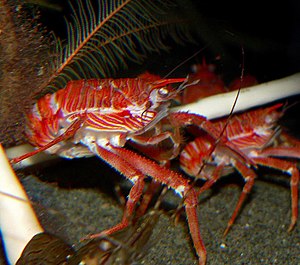Medium crayfish
| Medium crayfish | ||||||||||||
|---|---|---|---|---|---|---|---|---|---|---|---|---|

Jumping crayfish ( Munida quadrispina ) |
||||||||||||
| Systematics | ||||||||||||
|
||||||||||||
| Scientific name | ||||||||||||
| Anomura | ||||||||||||
| MacLeay , 1838 |
The medium crayfish (Anomura) are a suborder of the deciduous crabs . It includes u. a. the groups of hermit crabs and porcelain crabs .
features
The naming of the middle crabs goes back to a historical classification of the decapods. In the former, a distinction was made between a short abdomen ( brachyura ) and a long, lobster-like abdomen (macrura). Those decapods that could not be clearly assigned to one of these groups were placed in the middle crabs (Anomura). Therefore, this partial order is still quite heterogeneous today, especially with regard to the morphology and also the populated habitats of these crabs, which range from terrestrial to the deep sea, such as the yeti crab , such as the palm thief .
Like all decapods, medium crabs have five pairs of striding legs . However, the fifth and rearmost pair is reduced and is not used for locomotion and can possibly. a. present as modified cleaning legs. The carapace is not fused with the epistome as is the case with the crabs and is weakly or completely calcified, as well as in the most varied of ornamentation and shape. The pleon of the middle cancers may have pleura or no evidence of this segmentation. It can be elongated, hidden under the carapace or twisted to hold a snail shell in place.
In the phylogenetic system, the middle crabs are the sister group of crabs (Brachyura) and together with them form the taxon Meiura.
Systematics
The middle crayfish are divided into seven superfamilies with 20 families:
- Aegloidea Dana, 1852
- Aeglidae Dana, 1852
-
Chirostyloidea Ortmann, 1892
- Chirostylidae Ortmann, 1892
- Eumunididae A. Milne-Edwards and Bouvier, 1900
- Kiwaidae Macpherson, Jones & Segonzac, 2005
-
Galatheoidea Samouelle, 1819
- Spring crabs (Galatheidae Samouelle, 1819 )
- Munididae Ahyong, Baba, Macpherson & Poore, 2010
- Munidopsidae Ortmann, 1898
- Porcelain crabs (Porcellanidae Haworth, 1825 )
-
Hippoidea Latreille, 1825
- Mole crabs (Albuneidae Stimpson, 1858 )
- Blepharipodidae Boyko, 2002
- Sand crab (Hippidae latreille, 1825 )
-
Lithodoidea Samouelle, 1819
- Hapalogastridae Brandt, 1850
- Stone and king crabs (Lithodidae Samouelle, 1819 )
- Lomisoidea Bouvier, 1895
- Lomisidae Bouvier, 1895
-
Hermit crabs (Paguroidea latreille, 1802 )
- Land Hermit Crabs (Coenobitidae Dana, 1851 )
- Left-handed hermit crabs (Diogenidae Ortmann, 1892 )
- Right-handed hermit crabs (Paguridae Latreille, 1802 )
- Deep-sea hermit crabs (Parapaguridae Smith, 1882 )
- Pylochelidae Smith, 1882
- Pylojacquesidae McLaughlin & Lemaitre, 2001
literature
- Svein A. Fosså / Alf Jacob Nilsen: Coral Reef Aquarium , Volume 6, Birgit Schmettkamp Verlag, Bornheim 1998, ISBN 3-928819-18-6
Individual evidence
- ↑ a b P.A. McLaughlin, CB Boyko, KA Crandall, T. Komai, R. Lemaitre, M. Osawa, DL Rahayu: Annotated checklist of anomuran decapod crustaceans of the world (exclusive of the Kiwaoidea and families Chirostylidae and Galatheidae of the Galatheoidea) - Preamble and scope . In: The Raffles Bulletin of Zoology . Supplement No. 23, 2010, p. 1–4 ( PDF, 56kB [accessed January 25, 2013]).
- ↑ Jonas Keiler & Stefan Richter: Morphological diversity of setae on the grooming legs in Anomala (Decapoda: Reptantia) revealed by scanning electron microscopy . In: Zoologischer Anzeiger . tape 250 , 2011, pp. 343-366 , doi : 10.1016 / j.jcz.2011.04.004 .
- ↑ Sammy De Grave, N. Dean Pentcheff, Shane T. Ahyong et al .: A classification of living and fossil genera of decapod crustaceans . In: Raffles Bulletin of Zoology . Supplement No. 21. 2009, p. 1–109 ( pdf 7.73Mb [accessed March 11, 2012]).
- ^ ST Ahyong, K. Baba, E. Macpherson, GCB Poore: A new classification of the Galatheoidea (Crustacea: Decapoda: Anomura) . In: Zootaxa . tape 2676 , 2010, p. 57–68 ( PDF, 333kB [accessed January 24, 2013]).
- ↑ KE Schnabel, ST Ahyong, EW Maas: Galatheoidea are not monophyletic - Molecular and morphological phylogeny of the squat lobsters (Decapoda: Anomura) with recognition of a new superfamily . In: Molecular Phylogenetics and Evolution . tape 58 , 2011, p. 157–168 ( PDF, 1.3MB [accessed January 24, 2013]).


